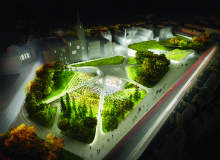
The North Sea oil boom of the 1970s saw the energy sector overshadow many of the traditional businesses of industrial Aberdeen, on Scotland’s west coast. Shipbuilding, fishing and paper-making were all slowly squeezed out, but the city never had to face the architectural consequences of rapid deindustrialisation, being fortunate enough to strike oil at about the same time Britain stopped making anything.
And yet the oil era did not bring with it the kind of public investment one might have expected. There is, in Aberdeen, very little evidence to support the favoured claims of trickle-down economics; a cracked retail thoroughfare, wider urban decline, nothing new of value and old stereotypes of grimness in the ‘Granite City’ remain latched to the legacy of those parsimonious years.
When plans to transform the city’s Union Terrace Gardens – an old, 18th-century bleaching green – were first raised in 2010 as part of a wider programme to regenerate Aberdeen’s ‘civic heart’, you’d have been forgiven for assuming they would be greeted with enthusiasm. And not just by the oilmen eager to improve the commercial prospects of the region, but by a general public deeply realistic about the state of their city.
DS&R: from New York to Aberdeen
Responsibility for the £140m redevelopment was awarded to US firm Diller Scofidio and Refro (DS&R), which beat a number of other architecture practices in a competition held last January. Already well known for its universally admired work on the New York High Line Gardens, the practice was chosen for its understanding of the role green space plays in urban design as well as the wider transformative effect of public area on communal life.
But despite that reputation, the Aberdeen public were not receptive. Unlike the High Line Gardens – a recreational green space closely embedded into a disused 1930s elevated rail line – many viewed the City Garden Project as fundamentally disconnected from the area it was designed for.
See Also:
To the despair of business leaders, this was never a project that captured the hearts and minds of the wider city. And for those reasons, amongst others, the councillors eventually voted against it. But deep questions still remain. Why was the plan so controversial and what does this tell us about contemporary urban design? Why did a city that so desperately needed a cultural and architectural facelift vote down the very idea intended to help it achieve it?
How well do you really know your competitors?
Access the most comprehensive Company Profiles on the market, powered by GlobalData. Save hours of research. Gain competitive edge.

Thank you!
Your download email will arrive shortly
Not ready to buy yet? Download a free sample
We are confident about the unique quality of our Company Profiles. However, we want you to make the most beneficial decision for your business, so we offer a free sample that you can download by submitting the below form
By GlobalDataA commonly owned, historic green space
The Union Terrace Gardens is a commonly owned, historic green space, situated at the heart of Aberdeen. In the early 19th century, the area was used by locals as a bleaching green to whiten their linen, but it soon fell into disrepair. In 1879, the gardens were reopened, this time with the council in charge of general upkeep, and it remains broadly the same to this day.
DS&R’s idea was to turn the green space into an imposing web of spindly concrete walkways nestling over the commons beneath. But some well-known locals, including the ever-agitating pop star Annie Lennox, spoke out against the aesthetics of the plan, calling it "a dog’s dinner of crap concrete".
That may or may not be a fair assessment of DS&R’s vision but it rang true with a lot of Aberdeen’s residents. A network of activists soon began a concerted campaign to stop the plan. This was, for them, an imposing piece of futuristic architecture foisted upon an historical area surrounded by equally historical buildings. In their eyes, it was too disengaged for the sunken gardens and for the general public who cherished them.
In his book A New Kind of Bleak: Journeys Through Urban Britain, architecture critic Owen Hatherley neatly captures the public sentiment. "It may end up being an interesting piece of architecture," he says, "but it seems radically unsuited to the local climate." Speaking to me he added, "In terms of design, it wouldn’t offend me if it were put somewhere else. The point was that it involved the erasure of something that I don’t think should be erased."
Some dismissed such attitudes as backwards conservationism; the pointless valorisation of antiquity in any form over job creation, cultural renewal and architectural progress. Speaking after the council vote, local tycoon Ian Wood said, "The key losers are the present and future citizens," adding that "future generations looking back on the oil era will wonder why, after years of under-investment, our council failed to grasp the opportunity to do something transformational."
Nor would it be fair to suggest DS&R deliberately ignored the value of context. Sir Duncan Rice, chair of the jury that picked the winner in January 2012, spoke at length about the way the Diller Scofidio team "had thought long and hard about Aberdeen’s special history and unique needs. Answer by answer, they overwhelmed the jury with their vision and their sensitivity to the whole downtown context."
Build for the city, not the portfolio
Whatever side one chooses to take, deeper questions are clearly raised about the extent to which architects should incorporate local context and identity into the design of public space. After the flamboyance of the boom years and the rise of deliberately iconic building, there is a growing sense that international architecture practices can no longer afford to ignore the geographical, social and cultural norms of the areas in which they operate. That’s certainly the view of Stephen Bayley, outspoken cultural critic and self-proclaimed "ubiquitous know-it-all".
"Great architecture evolves out of being rooted in particular circumstances," he says. "That doesn’t mean the fogeyish, slavish imitation of what’s gone before, it means finding some sort of meaningful relationship to its history. And that’s why the Aberdeen scheme feels wrong. It just wasn’t organic."
Bayley blames the rootlessness of much contemporary architecture on the legacy of deconstructivists like Frank Gehry, whose "grand-standing, show-boating and statement-making megalomania" led to what he drily calls "the trivialisation of architecture into meretricious shape-making".
Indeed it was Gehry himself who was responsible for the famous Bilbao Guggenheim, a piece of "iconic" architecture that turned an everyday industrial port into a hub of culture. Scores of other cities – Aberdeen included – have tried to emulate the so called "Bilbao effect", using stand-alone artistic projects as a genuine model for wider urban regeneration.
"There isn’t a dim city council anywhere that’s not thinking let’s hire so-and-so and achieve total urban regeneration," Bayley adds. "Obviously that’s not how great cities happen."
It’s also unclear if a shift away from "swooshy iconography" to buildings of enduring value and meaning has actually permeated into the discourse of architects. The intoxicating power of the boom years may now seem illusory, but the need for statement is an urge that may never fade.
"Judging by the number of press releases I get with the word ‘icon’ in the subject or body, I’m not sure there’s much evidence of any shift," Bayley muses.
Who owns the city?
The controversy surrounding the City Garden Project also gets to the core of basic philosophical questions about the privatisation of public space. The private sector – led by Wood – was set to raise most of the money for the project, taking rights away from the council and into his own hands.
This shift towards public-private space is a classic mark of post-modern urban development. While a lot of land remains accessible to the public, ownership and control has slipped away from the centralised planning system at the heart of the post-war consensus.
The result, according to critics like Anna Minton, is the creation of "defensible architecture" and unaccountable, often stringent, rules on what constitutes acceptable behaviour. Political protest, photography, busking and cycling are all banned activities in the strictures of privately owned space.
"When multinational property companies take over the ownership and control of a space," she says, "they aren’t looking to create a part of the city constructed in tune with the traditions and heritage of the surrounding area; they’re looking to create places that are going to make the most money. And, as the French sociologist Henri La Sebre said over 40 years ago: ‘If you look at place purely as a product, you will create things that all come to look identical’."
That template for new urban development may finally have come to an end after the model on which it was based – debt and speculation – so dramatically failed.
But now still seems like a pertinent time to ask ourselves these basic philosophical questions, to reconcile the problems associated with private ownership and find out exactly who owns the city.




